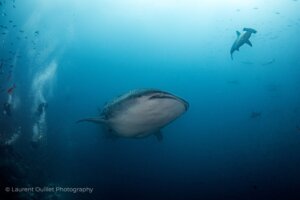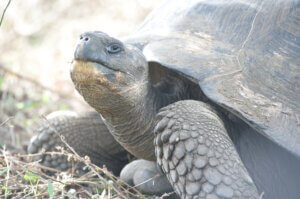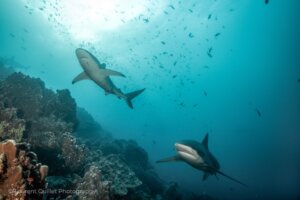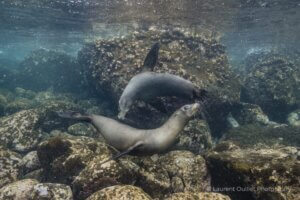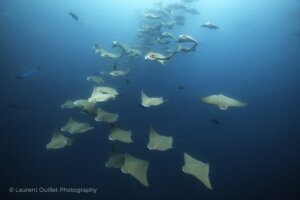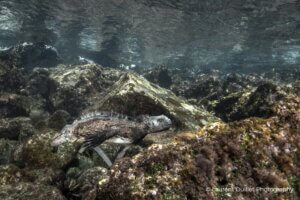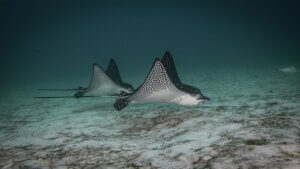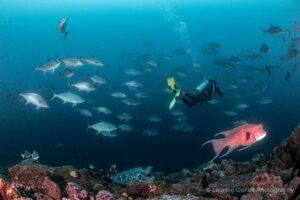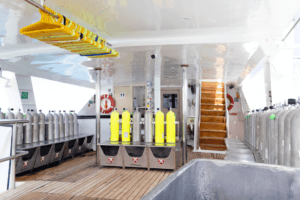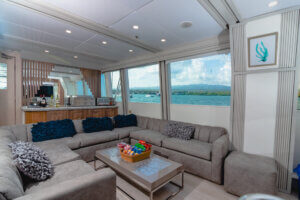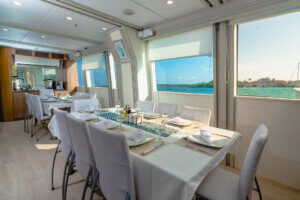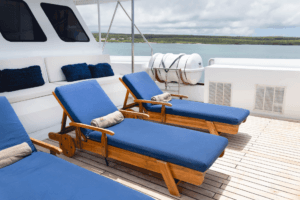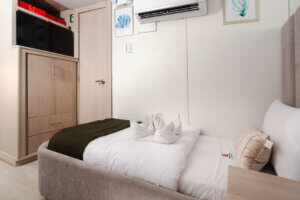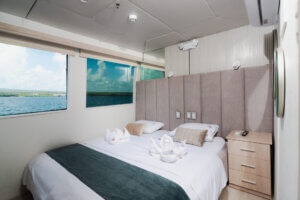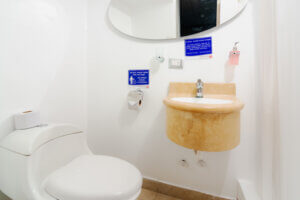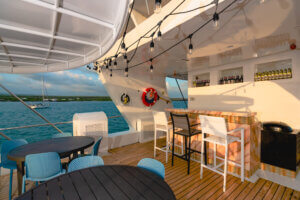Your Galapagos Liveaboard diving adventures in will encompass everything from sharks to nudibranchs, and more. The islands are best known for amazing shark diving around Wolf and Darwin Islands. These small and remote islands are best reached by liveaboard vessels for divers. Your diving experience here will generally include Galapagos sharks, silky sharks, and lots of schooling hammerheads being cleaned by king angelfish. Seeing marine turtles, schools of tuna, eagle rays, and sea lions are very common, and seeing a whale shark is very possible from June through November. All the islands you travel to are amazing sites for underwater photography.
Macro photographers will have their fill of sea horses, barnacle blennies, coral hawkfish, and many others. An abundance of rays is at many of the dive sites (including spotted rays, marble rays, golden rays, and stingrays) along with sea lions, sea turtles, schools of grunts, and snappers. The variety of life in the water is unlike any other place, with thick schools of the native brown striped Salema, snappers, groupers, Chevron barracuda, and huge sea turtles.
The weather in the Galapagos has water temperatures ranging from 65 -75 degrees F from December through May and 60 – 70 (F) June through November. Water temperatures are at the higher end of the scale in both Darwin and Wolf. Air temperatures range from 75 (F) or higher in the rainy season (December-May) to the mid ’60s (F) during the dry season (June – November), with nearly constant sea breezes.
Currents can range from 1 to 5 knots at the sites we visit, and visibility is generally between 30 and 80 feet. Most divers are comfortable with a 7mm wetsuit June – November with a hooded vest and gloves and a minimum 5 mm wetsuit December - May. Gloves and hoods are strongly recommended.
Your Galapagos liveaboard dives will be done from the pangas with an easy backward roll into the water. After you dive, your tank will be lifted back into the panga and you will board via its stern ladders or with assistance from the side.
Please note that all trips onboard Humboldt Explorer® are now operated from Baltra to Baltra (Airport code GPS). We will not sail from/to San Cristobal island anymore. Itineraries are subject to change due to weather and government regulations.
Monday: Baltra
Guests fly to the Galapagos Islands from Mainland Ecuador, arriving in the late morning. The dive guides will meet the guests at the airport between 11:00 am and 12 pm and escort them to the Galapagos liveaboard, Humboldt Explorer. Guests will board the vessel, have lunch, organize equipment and listen to the safety briefings.
Tuesday: Baltra North (2 Dives)
Equipement check, 7:00 and 10:00 dives
Sightings include rays and schools of fish.
Afternoon North Seymour land visit. Walk the path around North Seymour Island to see the large colonies of Blue Footed Boobies and Frigate Birds. Sighting of Sea Lions and Marine Iguanas are also common.
Depart for Northern Islands (long transit).
Wednesday: Wolf Island (3-4 Dives)
10:30, 2:00 and 4:30 dives. Possible night dive.
Sightings often include hammerheads, whale sharks, eagle rays, sea lions, Galapagos sharks, and silky sharks.
Night anchor at Wolf Island.
Thursday: Wolf Island (2 Dives)
6:30 and 9:30 dives
Transit to Darwin Island (2 Dives)
2:00 and 4:30 dives.
Sightings often include hammerheads, red-lipped batfish, eagle rays, sea lions, Galapagos sharks, and silky sharks.
Friday: Darwin Island (4 Dives)
6:30, 10:30, 2:00 and 4:30 dives.
Sightings often include hammerheads, whale sharks (in season) eagle rays, Galapagos sharks, and silky sharks.
Transit to Wolf Island
Saturday: Wolf Island (3 Dives)
6:30, 9:00 and 11:00 dives.
Sightings often include hammerheads, whale sharks (in season), eagle rays, Galapagos sharks, and silky sharks.
Long transit to Cousin’s Rock (20+ hours)
Sunday: Cousin’s Rock (1-2 Dives)
6:30 and 9:30 dives (number of dives dependent on travel time from Wolf Island)
This is great macro diving with an excellent chance of seeing sea horses, sea lions, and eagle rays. Lunch will be served while transiting to Santa Cruz (3 hours). Travel by bus to the Santa Cruz Highlands to visit the giant tortoises in their natural habitat. Visit the town of Puerto Ayora and the Darwin Centre on your own. Dinner on your own in Puerto Ayora. Return to the Humboldt Explorer at 8:30 pm.
Monday:Baltra
Depart the vessel by 9 am. Transfer to the airport.

